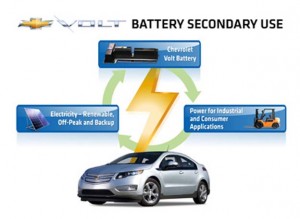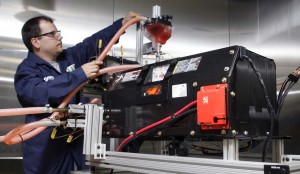Though General Motors expects the batteries in its Chevrolet Volt plug-in hybrid to last at least 100,000 miles the maker has formed a new partnership to find ways to continue using the lithium-ion packs once they’re no longer suitable for automotive applications.
The Detroit maker is partnering with the ABB Group to explore ways old Volt batteries can be used to improve the effectiveness of wind, solar and other renewable energy sources. Old batteries might also provide consumers a way to minimize the impact of grid disruptions, and to take advantage of lower off-peak energy rates, the partners suggest.
“The Volt’s battery will have significant capacity to store electrical energy, even after its automotive life,” said Micky Bly, GM Executive Director of Electrical Systems, Hybrids, Electric Vehicles and Batteries. That presents potential opportunities, added Bly, “to provide environmental benefits that stretch far beyond the highway.”
Each Chevy Volt will carry 16 kilowatt-hours of lithium-ion batteries – which are expected to deliver, on average, about 40 miles of driving on electric power alone. To maximize the life of that pack, GM will only use, at most, about half of the energy capacity of each battery, however. So, by the end of its life under the hood, the packs are expected to still have significant life left.
“There is a point we’ll be required (by federal regulations still being finalized) to turn on the change-battery light” on the Volt’s instrument panel, noted Bly. But at that point it will have about “50 to 70% of its life left.”
That’s where ABB comes in. The firm is the world’s largest supplier of power grid systems, and has already been looking at ways to improve the efficiency and reliability of power line systems. That will become even more important in the years ahead, experts agree, as the world migrates to more renewable energy sources.
The problem is that wind and solar power aren’t available all the time. A recent, unexpected lull in wind generation nearly crashed the Texas energy grid. So the industry is looking for ways to make sure it maintains a stable load at all times, and a network of battery “farms” is one possible way of addressing the challenge. Used batteries might also be put to work in such applications as cellphone towers – or even in the home, where a consumer could continue to operate during a blackout or charge up at night, at lower rates, and use the battery during peak hours.
“Future smart grids will incorporate a larger proportion of renewable energy sources and will need to supply a vast e-mobility infrastructure – both of which require a wide range of energy storage solutions,” said Bazmi Husain, head of ABB’s smart grids initiative. “We are excited to explore the possibility of employing electric car batteries in a second use that could help build needed storage capacity and provide far-reaching economic and environmental benefits.”
GM isn’t the only automaker looking for ways to reuse old batteries. Nissan has been searching out opportunities for the batteries in its new Leaf electric vehicle, among others.
While battery technology is expected to ramp up slowly, it could account for anywhere from 5% to 10% of total global vehicle production by decade’s end, according to proponents. If they’re on target, that would mean as many as 6 million or more vehicles a year that would eventually have battery packs needing reuse or recycling.


